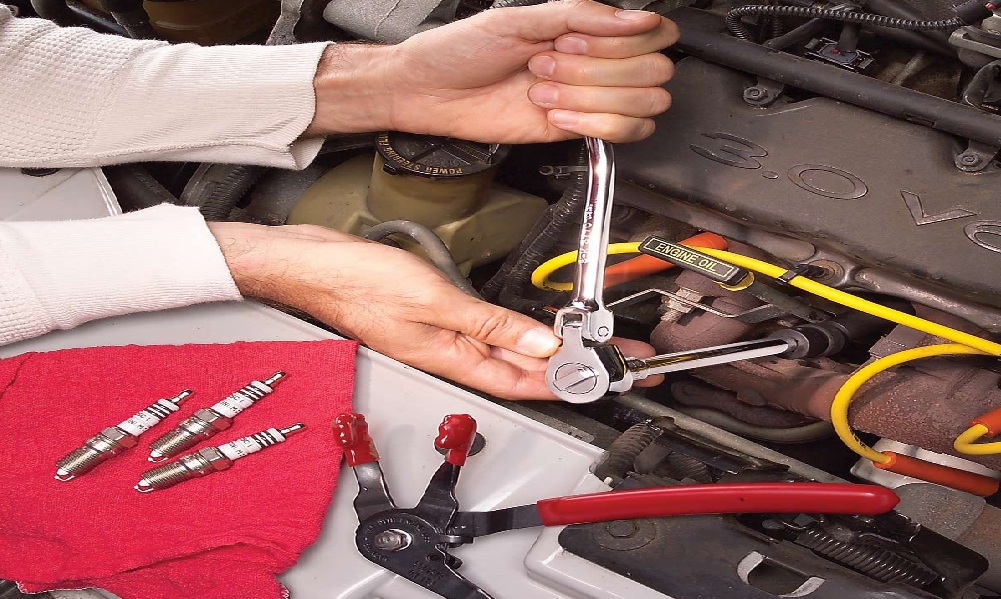DIY Spark Plug Replacement: What Can Go Wrong Without Help
Replacing spark plugs is often seen as a straightforward maintenance task that many car enthusiasts and DIY mechanics are eager to tackle. However, this seemingly simple job can quickly turn into a complex ordeal if not approached with the right knowledge and caution. Let’s explore the various issues that can arise during a DIY spark […]
Replacing spark plugs is often seen as a straightforward maintenance task that many car enthusiasts and DIY mechanics are eager to tackle. However, this seemingly simple job can quickly turn into a complex ordeal if not approached with the right knowledge and caution. Let’s explore the various issues that can arise during a DIY spark plug replacement, helping you avoid common mistakes and potential damage to your vehicle.

Incorrect Spark Plug Selection
One of the most critical errors in DIY spark plug replacement is choosing the wrong type of spark plug for your vehicle.
Consequences:
- Poor engine performance: Using spark plugs with the wrong heat range can lead to pre-ignition or fouling.
- Reduced fuel efficiency: Incorrect spark plugs may not provide optimal combustion, leading to increased fuel consumption.
- Potential engine damage: In extreme cases, using the wrong spark plugs can cause serious damage.
How to avoid:
- Always consult your vehicle’s owner manual for the correct spark plug specifications.
- Double-check the part number and specifications when purchasing replacement plugs.
- If in doubt, consult with a professional mechanic or the vehicle manufacturer.
Improper Gapping
The spark plug gap is the distance between the center and ground electrodes. Incorrect gapping can significantly affect engine performance.
Consequences:
- Misfires: Too wide a gap can cause the spark to fail, leading to engine misfires.
- Poor fuel economy: Incorrect gapping can result in incomplete combustion, wasting fuel.
- Reduced performance: The engine may lack power or run roughly due to improper spark generation.
How to avoid:
- Use a feeler gauge to check and adjust the gap according to manufacturer specifications.
- Be gentle when adjusting the gap to avoid damaging the electrodes.
- Remember that some modern spark plugs come pre-gapped and should not be adjusted.
What is Cross-Threading?
Cross-threading occurs when the spark plug is not properly aligned with the threads in the cylinder head during installation.
Consequences:
- Damaged threads: This can lead to expensive repairs, potentially requiring thread repair or even cylinder head replacement.
- Compression leaks: A poorly seated spark plug can allow compression to escape, reducing engine efficiency.
- Difficulty in future replacements: Once threads are damaged, future spark plug replacements become much more challenging.
How to avoid:
- Start threading the spark plug by hand to ensure proper alignment.
- Use a torque wrench to tighten the plug to the manufacturer’s specifications.
- If you feel resistance when threading, stop and realign the plug before continuing.
Don’t Over-Tighten
Applying too much force when installing spark plugs can lead to several issues.
Consequences:
- Stripped threads: Excessive force can strip the threads in the cylinder head.
- Cracked spark plug insulators: Over-tightening can crack the ceramic insulator, leading to immediate failure.
- Difficulty in future removal: An over-tightened plug may be extremely difficult to remove during the next replacement.
How to avoid:
- Always use a torque wrench and follow the manufacturer’s torque specifications.
- If you don’t have a torque wrench, be cautious and err on the side of under-tightening rather than over-tightening.
- Remember the saying: “Snug is good, tight is too much.”
Spark Plug Wires or Coil-on-Plug Boots
During removal and installation, careless handling of spark plug wires or coil-on-plug boots can cause damage.
Consequences:
- Electrical arcing: Damaged insulation can cause the spark to arc to the engine block, resulting in misfires.
- Reduced performance: Poor connection between the plug and wire/boot can lead to incomplete combustion and reduced engine performance.
- Increased emissions: Misfires from damaged wires or boots can increase harmful emissions.
How to avoid:
- Use proper spark plug wire pliers or boot pullers to remove wires or boots.
- Never pull on the wire itself; always grip the boot.
- Inspect wires and boots for damage before reinstallation.
Debris into the Cylinder
When removing old spark plugs, there’s a risk of debris falling into the open cylinder.
Consequences:
- Engine damage: Debris can cause scoring of cylinder walls or damage to valves when the engine is started.
- Reduced compression: Small particles can prevent proper sealing of valves or piston rings.
- Catalytic converter damage: If debris is expelled from the cylinder, it can damage the catalytic converter.
How to avoid:
- Clean the area around the spark plug wells thoroughly before removal.
- Use compressed air to blow out any loose debris before removing the plug.
- Consider using a spark plug socket with a rubber insert to hold the plug during removal.
Incorrect Spark Plug Socket Usage
Using the wrong tools, particularly an incorrect socket size or type, can lead to problems.
Consequences:
- Damaged spark plug: Using a socket that doesn’t fit properly can crack the ceramic insulator or damage the electrode.
- Rounded hex on the plug: An ill-fitting socket can round off the hex on the spark plug, making it difficult to remove.
- Incomplete tightening: A socket that doesn’t grip the plug properly may lead to under-tightening.
How to avoid:
- Use a dedicated spark plug socket of the correct size.
- Ensure the socket has a rubber insert to hold the plug securely.
- Double-check that the socket fully engages the hex on the spark plug before applying force.
Don’t Mishandle Stuck or Seized Spark Plugs
Dealing with stuck spark plugs improperly can turn a simple job into a major repair.
Consequences:
- Broken spark plugs: Applying too much force can cause the plug to break, leaving part of it in the cylinder head.
- Damaged threads: Forcing a seized plug can damage the threads in the cylinder head.
- Extended downtime: A broken plug or damaged threads can require significant time and expense to repair.
How to avoid:
- If a plug is stuck, apply a penetrating oil and allow it to soak.
- Use a proper spark plug removal tool designed for seized plugs.
- Consider seeking professional help if you’re unsure about removing a stuck plug.
Don’t Neglect to Check Plug Reach
Installing spark plugs with incorrect reach (the threaded portion’s length) can cause serious issues.
Consequences:
- Piston damage: A plug that’s too long can contact the piston, causing immediate and severe damage.
- Poor performance: A plug that’s too short may not properly ignite the air-fuel mixture.
- Overheating: Incorrect reach can affect heat dissipation, potentially leading to pre-ignition or engine knock.
How to avoid:
- Always use spark plugs with the correct reach as specified by the vehicle manufacturer.
- If changing to a different brand, cross-reference the part numbers to ensure equivalent reach.
- When in doubt, compare the new plug side-by-side with the old one before installation.
Why Not To Ignore Anti-Seize and Dielectric Grease
Failing to use anti-seize compound on plug threads or dielectric grease on boots can lead to future problems.
Consequences:
- Seized plugs: Without anti-seize, plugs can become extremely difficult to remove during the next replacement.
- Moisture intrusion: Lack of dielectric grease can allow moisture to enter the connection between the plug and wire/boot.
- Voltage leaks: Improper use of dielectric grease can cause voltage to leak, resulting in misfires.
How to avoid:
- Apply a small amount of anti-seize compound to spark plug threads, unless specified otherwise by the manufacturer.
- Use dielectric grease inside the spark plug boot to prevent moisture intrusion and ease removal.
- Be careful not to apply grease to the electrode or allow it to enter the combustion chamber.
Don’t Misdiagnose the Need for Replacement
Replacing spark plugs unnecessarily or failing to replace them when needed can lead to issues.
Consequences:
- Wasted time and money: Replacing plugs that are still good is an unnecessary expense.
- Potential for introducing problems: Each time you remove and replace plugs, there’s a risk of causing one of the issues mentioned above.
- Continued poor performance: Failing to replace worn plugs can result in ongoing engine performance issues.
How to avoid:
- Follow the manufacturer’s recommended replacement interval.
- If experiencing engine issues, diagnose properly before assuming spark plugs are the culprit.
- Inspect old plugs after removal to understand their condition and confirm if replacement was necessary.
Don’t Neglect to Check Related Components
Focusing solely on the spark plugs while ignoring related components can leave underlying issues unresolved.
Consequences:
- Recurring problems: If you ignore issues with ignition coils, wires, or the distributor, new plugs may not solve the problem.
- Shortened plug life: Faulty-related components can cause new spark plugs to wear out prematurely.
- Incomplete repair: The vehicle may continue to experience performance issues if you ignore all ignition system components.
How to avoid:
- Inspect spark plug wires, boots, and ignition coils for signs of wear or damage.
- Check the distributor cap and rotor (if applicable) for signs of wear or carbon tracking.
- Consider replacing related components if they are near the end of their service life.
DIY Spark Plug Replacement: Call A Professional Instead
While DIY spark plug replacement can be a rewarding and cost-effective task, it’s crucial to approach it with caution and proper knowledge. The potential pitfalls outlined in this guide highlight the importance of thorough preparation, the right tools, and careful execution. You can complete a spark plug replacement and maintain your engine’s performance by being aware of these common issues and avoiding them.
Remember, if you feel unsure or uncomfortable with the process at any point, there’s no shame in seeking the help of a professional mechanic. The cost of professional installation is often far less than repairing damage caused by improper DIY work. Whether you tackle the job yourself or leave it to the pros, regular spark plug maintenance is key to keeping your engine running smoothly and efficiently for years.


